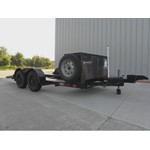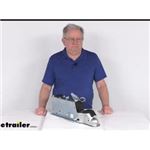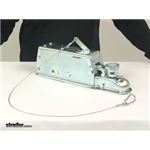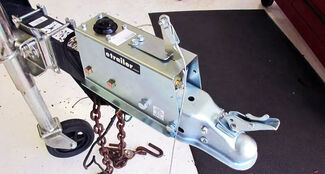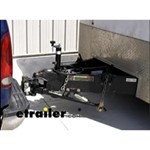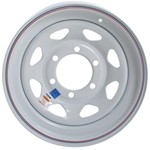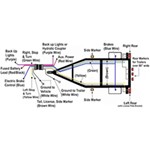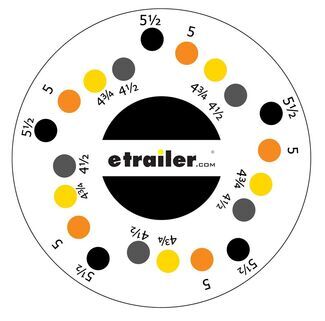
How To Check if Trailer Surge Brakes Are Working Properly On Tandem Axle Boat Trailer
Published 12/23/2009
Products Featured in This Question
Question:
I have a 2007 Starline tandem Axle Alum boat trailer with brakes on all four wheels. I recently had an issue with my dog biting through the line furthest away from the master cylinderright rear this past summer. I repaired the broken line and I performed a gravity bleed of all the brakes. I had clear fluid come out from all brakes and was replacing fluid as performed this type of bleeding. This past few months it appears that my brakes are not engaging when I come to a stop or slowing down. How do I check if the brakes are properly working or might be sticking? Is there a way to check the calipers if they are closing with out having the trailer in motion. The master cylinder is full of fluid and I dont have any leaks. Do I need to bleed the brakes again? Need Help!
asked by: Joel G
Expert Reply:
Checking the brakes can be done in two ways. The easiest way is to raise one side of the trailer and spin the wheels while someone applies the surge brakes at the coupler. The better way would be to remove each of the wheels and brake drums and activate the brakes while making sure the wheel cylinders and brake assemblies are functioning properly.
After this the first thing I would do is bleed the brakes using the trailers surge coupler to force the fluid from the brake lines and make sure there is no air in the system. If there is air in the system you will not have brakes and this sounds like the problem.
To bleed the brakes start at the rear most axle and the wheel closest to the T in the brake line. Open the bleeder valve and attach a hose that you run into a clear bottle. Fill the master cylinder with the proper brake fluid and then activate the trailer brakes until the fluid runs without air bubbles. Your model may have a lever or a place under the coupler to activate the brakes with a wrench. If your actuator does not have another option you will need to manually move the coupler, where the ball attaches, to activate the brakes for bleeding. Once you have the first brake bled go the the other brake on that axle and then work forward always starting with the brake closest to the T in the brake line.
If you bleed the brakes in this fashion you will know that the master cylinder is performing and that there is no air in the system causing the situation. You would then need to check the wheel cylinders and brake assemblies for problems. If the brake assemblies are the problem it may be easier just to replace the whole assembly with new ones. For 10 inch marine brakes you would need item # 18787 and # 18788, and for 12 inch marine brakes you would need item # 23510 and # 23511.

Product Page this Question was Asked From
Demco Hydraulic Drum Brake Assembly - Single Servo - Galvanized - 10" - Right Hand - 3,500 lbs
- Accessories and Parts
- Trailer Brakes
- Hydraulic Drum Brakes
- RH
- 3500 lbs
- Brake Assembly
- Single Servo
- 10 x 2-1/4 Inch Drum
- Demco
more information >
Featured Help Information
Miscellaneous Media

Continue Researching
- Search Results: trailer brakes
- Search Results: kodiak 225 caliper
- Shop: Demco Hydraulic Brake Actuator - Drum - Zinc - 2" Ball - 7,000 lbs
- Search Results: brake actuator
- Search Results: trailer hitch
- Shop: Trailer Hitch
- Search Results: brake control
- Shop: Kodiak Hydraulic Brake Line Kit - Single Axle - 18'
- Shop: Kodiak Disc Brake Caliper - Dacromet - 3,500 lbs to 6,000 lbs
- Shop: Replacement DeeMaxx Disc Brake Caliper - Maxx Coating - 3,500 lbs to 6,000 lbs
- Shop: Convert-A-Ball Cushioned 5th-Wheel-to-Gooseneck Adapter - 12" to 16" Tall - 20,000 lbs
- Search Results: 8~219
- Search Results: bigfoot jack
- Video: What to Know About the Demco Hydraulic Brake Actuator-DM72VR
- Shop: Trailer Hub and Drum Assembly - 5,200-lb and 6,000-lb Axles - 12" - 6 on 5-1/2 - Pre-Greased
- Shop: Trailer Wiring
- Shop: Truck Mud Flaps - Black Rubber - 24" Wide x 36" Tall - Qty 2
- Video: Review of the Fulton Boat Trailer Jack w/ Wheel
- Video: The Low-Down on the Hydraulic Brake Kit
- Video: Review of Demco Brake Actuator - Reverse Lockout Solenois Kit - DM5836
- Video: Checking Out the Kodiak Hydraulic Brake Line Kit
- Video: Checking Out the Trailer Hub and Drum Assembly
- Q&A: Recommended Replacement for Dico Model 60 Actuator
- Article: How to Bleed Your Trailer Surge Brakes
- Q&A: Tie Down LP7000 Brake Actuator Replacement
- Q&A: Installing a Brake Controller on a 2003 Ford F-150 Without a Factory Trailer Connector
- Video: Feature Breakdown: Dexter Zinc-Plated Brake Actuator
- Shop: Brake Controller
- Q&A: Can Electric Brakes be Used on a Boat Trailer
- Q&A: Cross Reference For Disc Brakes for Trailer Based on Automotive Applications









